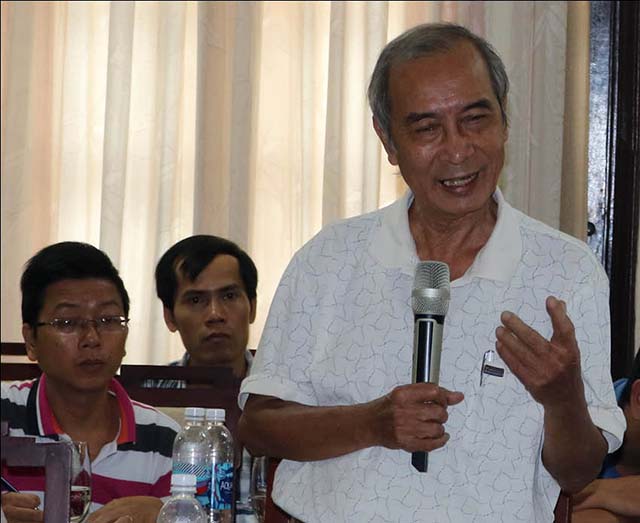
Researcher Nguyen Xuan Hoa expressed his opinions
Dr. Nguyen The Hung, Director of the Department of Cultural Heritage (Ministry of Culture, Sports and Tourism), Mr. Nguyen Dung, Vice Chairman of Thua Thien Hue People's Committee, and Ms. Nguyen Thi Hoi An, deputy director of Danang Department of Culture and Sports, attended the conference.
Two conservation and renovation options
Hai Van Quan monument is located on Hai Van Pass, in the area between Thua Thien Hue and Danang City. Holding many special values in terms of history, culture, architecture, military and landscapes, on April 14, 2017, Hai Van Quan was ranked as a National Cultural and Historical Monument by the Ministry of Culture, Sports and Tourism.
Under the Gia Long period (1802 - 1820), the Nguyen court ordered the construction of four service stations in Phu Loc district and renovated the road to Hai Van pass. The following Nguyen Dynasty kings were very concerned with this crucial position and many times issued edicts to enhance the security of the capital. But with time and the change of history, Hai Van Quan gradually lost its important role with the Hue court.
At the end of 1946, when the French returned to invade our country, Hai Van Quan was converted into a military base with many strong fortifications along the rugged mountain pass. After 1954, the system of houses, booths, fortifications ... was transferred to the US military. Hai Van Quan continued to be a military base. Many new construction and renovation works had distorted the original features.

The conference scene
Immediately after Hai Van Quan was classified as a national monument, the authorities carried out archaeological excavation of the monument to find scientific data through the period of existence of the monument. With the goal of restoring the Hai Van Quan site according to the original traces, simultaneously completing and coupling with the valuable architecture in the monument area, the consultancy unit - Institute of Science, Technology and Construction - introduced two optional plans to preserve and restore Hai Van Quan. The first option was to restore all the works within the boundary of Zone I to protect the monument, a section of the natural route to Hue and the slope toward Danang in the Nguyen Dynasty. Works between protected area I and II of the site would be preserved. Option two was to preserve the current condition of all works identified before 1975, especially the period of Don Nhat victory.
Continuing research and supplementing historical data
There were 8 delegates presenting ideas on preserving, renovating and promoting the value of Hai Van Quan. They focused on two main content areas: promoting the historical values of Hai Van Quan and agreeing on solutions to preserve, renovate, restore and promote the value of the monument. With the above two options, the delegates supported the solution to preserve the current condition of the Nguyen dynasty architecture in zone I. Contiguous works can be preserved and adapted as a part of the historical process.
To implement the plan successfully, the delegates also contributed many valuable and relevant opinions, such as: supplementing historical data on Hai Van Quan, calculating the relocation of Don Nhat victory stele, renovating and adapting bunkers, planning the parking lot, service area, information boards, and display and exhibition areas...
Many delegates suggested the need to continue to research and supplement more complete historical data on Hai Van Quan monument throughout the length of history. And importantly, in assessing the role of the dynasties and the historical periods of the formation of Hai Van Quan, there needs to be an acknowledgement of the merits of the classes of people who have shed blood and tears to build the pathway through this monument.
According to Dr. Nguyen The Hung, for additional historical information for the project, relevant units should consult documents from all sources, including sources from overseas Vietnamese. If necessary, consider expanding the archaeological area to exploit the data base.
It is not necessary to preserve all architectural works dating back to the Nguyen Dynasty in Hai Van Quan; at the same time, calculating the relocation of Don Nhat victory stele to a more appropriate position was the opinion of Assoc. Prof. Dr. Dang Van Bai (National Council of Cultural Heritage) and Ms. Nguyen Thi Hoi An (Deputy Director of Danang Department of Culture and Sports). Assoc. Prof. Dr. Dang Van Bai oriented towards option 1 plan with the ultimate goal to have a monument that is stable, has longevity and must be an attractive destination. However, it is not necessary to completely restore the monuments according to the original architecture, but depending on the actual conditions to restore them properly. The rest can be put on display and exhibition.
Speaking at the end of the workshop, Dr. Nguyen The Hung continued to ask the relevant units to take note of all comments of the delegates; continue to supplement materials to better identify the values of Hai Van Quan; take public opinion and act in accordance concerning the bunkers; and importantly, develop a plan to exploit and promote the value of Hai Van Quan. If Hue and Danang can do this, it will be a good lesson for many other localities in this sphere.
|
“On behalf of the leaders of Thua Thien Hue Province, we applaud the efforts of both localities in the early development of Hai Van Quan conservation and restoration plan in a standard way, to efficiently promote the value of the monument. After this conference, the leaders of the two localities will continue to sit together to agree on the most feasible option. Hopefully in the near future, Hai Van Quan will become an attractive tourist destination of the country and the pride of the people of ancient Thuan - Quang regions, now Hue - Da Nang,” Vice Chairman of the provincial People's Committee Nguyen Dung said. |
Story and photos: Dong Van
